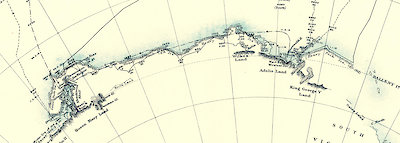Enter Aurora
Within a decade, humans returned to these waters. Having landed the Cape Denison party in January 1911, John King Davis attempted to reach the shore of what Wilkes had named ‘Knox Land’, but was stopped by ice. Further west, around 100°E, the ship arrived at a large projection which Mawson later named ‘Termination Ice Tongue’ (after Wilkes’s ‘Termination Land’) before entering open water, later to be named Davis Sea.
Aurora followed the 30-metre-high ice cliffs for well over 100 kilometres, roughly along the 95°East meridian of longitude. But about 25 kilometres from the coast, close to the ice shelf around 66°S, the ship was blocked by sea ice.
With Davis running out of time before re-freezing seas would force Aurora out of Antarctic waters, Wild made the brave decision to make his ‘Western Base’ on the ice shelf itself — one of a handful of Antarctic expeditions to do so. (Only one other Australian party has wintered on an ice shelf — the Amery Ice Shelf party in 1968.)
Mawson was later to name the whole, vast ice shelf in honour of the leader of his first Antarctic expedition of 1907–09, Ernest Shackleton.


